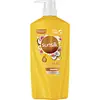What's inside
What's inside
 Key Ingredients
Key Ingredients

 Benefits
Benefits

 Concerns
Concerns

 Ingredients Side-by-side
Ingredients Side-by-side

Water
Skin ConditioningCetearyl Alcohol
EmollientDimethicone
EmollientStearamidopropyl Dimethylamine
EmulsifyingAmodimethicone
Behentrimonium Chloride
PreservativeCetrimonium Chloride
AntimicrobialDipropylene Glycol
HumectantDisodium EDTA
Hydrolyzed Keratin
HumectantLactic Acid
BufferingMagnesium Chloride
Magnesium Nitrate
Methylchloroisothiazolinone
PreservativeMethylisothiazolinone
PreservativeParfum
MaskingPEG-7 Propylheptyl Ether
Emulsion StabilisingPhenoxyethanol
PreservativeSclerocarya Birrea Seed Oil
HumectantSodium Chloride
MaskingBenzyl Alcohol
PerfumingHexyl Cinnamal
PerfumingLimonene
PerfumingLinalool
PerfumingWater, Cetearyl Alcohol, Dimethicone, Stearamidopropyl Dimethylamine, Amodimethicone, Behentrimonium Chloride, Cetrimonium Chloride, Dipropylene Glycol, Disodium EDTA, Hydrolyzed Keratin, Lactic Acid, Magnesium Chloride, Magnesium Nitrate, Methylchloroisothiazolinone, Methylisothiazolinone, Parfum, PEG-7 Propylheptyl Ether, Phenoxyethanol, Sclerocarya Birrea Seed Oil, Sodium Chloride, Benzyl Alcohol, Hexyl Cinnamal, Limonene, Linalool
Water
Skin ConditioningSodium Laureth Sulfate
CleansingCocamidopropyl Betaine
CleansingDimethiconol
EmollientArgania Spinosa Kernel Oil
EmollientCocos Nucifera Oil
MaskingCamellia Oleifera Seed Oil
Skin ConditioningPrunus Amygdalus Dulcis Oil
Skin ConditioningOlea Europaea Fruit Oil
MaskingPEG-45m
HumectantCarbomer
Emulsion StabilisingGuar Hydroxypropyltrimonium Chloride
Skin ConditioningTea-Dodecylbenzenesulfonate
CleansingTea-Sulfate
BufferingCyclotetrasiloxane
EmollientSynthetic Fluorphlogopite
Tin Oxide
AbrasiveSodium Chloride
MaskingCitric Acid
BufferingDisodium EDTA
Sodium Benzoate
MaskingPhenoxyethanol
PreservativeParfum
MaskingCI 77891
Cosmetic ColorantCI 19140
Cosmetic ColorantCI 17200
Cosmetic ColorantWater, Sodium Laureth Sulfate, Cocamidopropyl Betaine, Dimethiconol, Argania Spinosa Kernel Oil, Cocos Nucifera Oil, Camellia Oleifera Seed Oil, Prunus Amygdalus Dulcis Oil, Olea Europaea Fruit Oil, PEG-45m, Carbomer, Guar Hydroxypropyltrimonium Chloride, Tea-Dodecylbenzenesulfonate, Tea-Sulfate, Cyclotetrasiloxane, Synthetic Fluorphlogopite, Tin Oxide, Sodium Chloride, Citric Acid, Disodium EDTA, Sodium Benzoate, Phenoxyethanol, Parfum, CI 77891, CI 19140, CI 17200
Ingredients Explained
These ingredients are found in both products.
Ingredients higher up in an ingredient list are typically present in a larger amount.
Disodium EDTA plays a role in making products more stable by aiding other preservatives.
It is a chelating agent, meaning it neutralizes metal ions that may be found in a product.
Disodium EDTA is a salt of edetic acid and is found to be safe in cosmetic ingredients.
Learn more about Disodium EDTAParfum is a catch-all term for an ingredient or more that is used to give a scent to products.
Also called "fragrance", this ingredient can be a blend of hundreds of chemicals or plant oils. This means every product with "fragrance" or "parfum" in the ingredients list is a different mixture.
For instance, Habanolide is a proprietary trade name for a specific aroma chemical. When used as a fragrance ingredient in cosmetics, most aroma chemicals fall under the broad labeling category of “FRAGRANCE” or “PARFUM” according to EU and US regulations.
The term 'parfum' or 'fragrance' is not regulated in many countries. In many cases, it is up to the brand to define this term.
For instance, many brands choose to label themselves as "fragrance-free" because they are not using synthetic fragrances. However, their products may still contain ingredients such as essential oils that are considered a fragrance by INCI standards.
One example is Calendula flower extract. Calendula is an essential oil that still imparts a scent or 'fragrance'.
Depending on the blend, the ingredients in the mixture can cause allergies and sensitivities on the skin. Some ingredients that are known EU allergens include linalool and citronellol.
Parfum can also be used to mask or cover an unpleasant scent.
The bottom line is: not all fragrances/parfum/ingredients are created equally. If you are worried about fragrances, we recommend taking a closer look at an ingredient. And of course, we always recommend speaking with a professional.
Learn more about ParfumPhenoxyethanol is a preservative that has germicide, antimicrobial, and aromatic properties. Studies show that phenoxyethanol can prevent microbial growth. By itself, it has a scent that is similar to that of a rose.
It's often used in formulations along with Caprylyl Glycol to preserve the shelf life of products.
Chances are, you eat sodium chloride every day. Sodium Chloride is also known as table salt.
This ingredient has many purposes in skincare: thickener, emulsifier, and exfoliator.
You'll most likely find this ingredient in cleansers where it is used to create a gel-like texture. As an emulsifier, it also prevents ingredients from separating.
There is much debate on whether this ingredient is comedogenic. The short answer - comedogenic ratings don't tell the whole story. Learn more about comegodenic ratings here.
The concensus about this ingredient causing acne seems to be divided. Research is needed to understand if this ingredient does cause acne.
Scrubs may use salt as the primary exfoliating ingredient.
Learn more about Sodium ChlorideWater. It's the most common cosmetic ingredient of all. You'll usually see it at the top of ingredient lists, meaning that it makes up the largest part of the product.
So why is it so popular? Water most often acts as a solvent - this means that it helps dissolve other ingredients into the formulation.
You'll also recognize water as that liquid we all need to stay alive. If you see this, drink a glass of water. Stay hydrated!
Learn more about Water